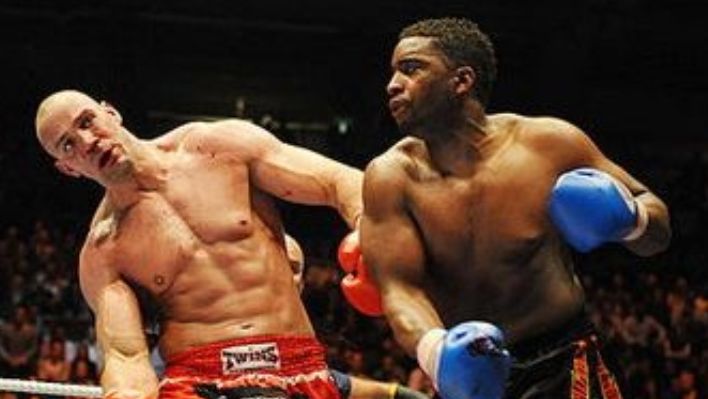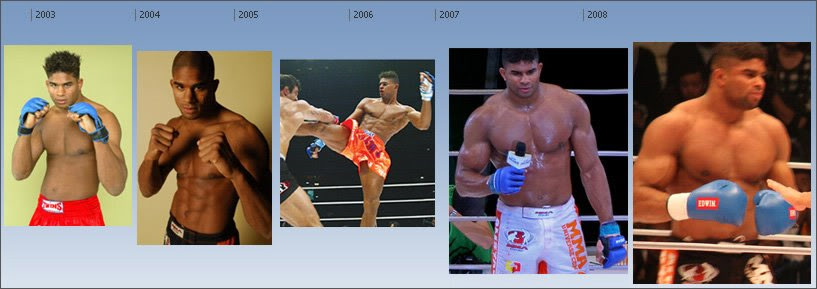Steroids in combat sports
The fact that bodybuilders use anabolic steroids to increase the muscle mass is well known and covered by the media. In professional kickboxing and mixed martial arts (MMA) anabolic steroids are used to get more (muscle) mass, to increase strength, endurance, pain tolerance and aggressiveness. Last year some Dutch fighters were caught with steroids and they faced the same problems with PCT as other users do. Except these cases where closely followed by the media and the fans.

Some history. In the Netherlands, the gyms had hours where people learned Judo and a bit later Karate, it turned out to be a success and gyms added a dojo, where the students had the change to train all day. Later followed by other fight sports like Savate, Kyokushinkai (full contact karate), Kickboxing, and Muay Thai, at least this is how it happened in our gym.
Some guys combined days in the dojo with power training and/or bodybuilding. Some of them wanted to add extra weight and power and started to use anabolic steroids. These guys became heavier than the standard Muay Thai fighters, originating from Thailand and fought by small lean guys that fought hard and quick. The new generation of Dutch fighters changed the training and fighting skills. Soon the Dutchies ruled in Muay Thai and specialized in knock-downs and knock-outs.
Personally I liked the style of Ramon Dekkers which was very spectacular and had lots of original techniques. The sport once dominated by the lightweights changed rapidly, in my opinion for the worst. It became a complete different sport when bigger and bigger musclebound giants stepped into the ring.
 Names as Jerome le Banner and giants like Bob Sapp probably will ring some bells.
Names as Jerome le Banner and giants like Bob Sapp probably will ring some bells.
Bob "The Beast" Sapp is an American kick boxer, MMA fighter and former world champion professional wrestler and professional American football player. Sapp became a popular MMA fighter in Japan, fighting in PRIDE and K-1 promotions, he was suspended by the NFL in 1998 for alleged steroid abuse and later his name showed up in connection to the BALCO steroid case.
Victor Conte said in an interview that Patrick Arnold had sol “a gallon of THG” to Bob Sapp.
K1 attracted many gold-diggers and Tyson signed a contract with K-1 back in 2003 following the incident with Bob Sapp. But Japan don't let convicted fellons enter the country so he never actually fought for K-1.
Instead of increasing the popularity of the K1, these gold-diggers, both fighters and promoters, ruined the sport. Nowadays gaining popularity in the former East-Block. In the USA mixed martial art (MMA) is very popular and some of these guys originate from the K1 scene, like Alistair Overeem.
First let’s take a look at the problems of Badr Hari, who is being accused of shattering the leg of a business man during a dance party, a heavy assault on a bouncer of a club in Amsterdam, He also has a history of battery and assault.
The police who searched Hari's apartment looking for evidence in the current assault case when they happened upon the collection of anabolic steroids and drug masking agents.
Acording Badr Hari the steroids as well as the masking agents used to fool blood tests did not belong to him. But he kept them for a third person
Badr Hari part of a list Dutch kick boxers and MMA fighters like Alistair Overeem, Errol Zimmerman and Tyrone Spong that all somewhere during their martial arts career made a remarkable growth spurt. Overeem (1m96, 119 (!) kilos) in the U.S. caught once with impermissible testosterone levels in his blood, and his fight was canceled.. More about Allistair Overeem later in this article
Prison food
 Genetically Hari is naturally more of a twig than a muscle hunk and the difference between pictures of a couple of years and more recently is striking. The big change came with his transfer to another weight trainer, Papa Mike (Mike Teckandan), who makes no secret of yhe fact that his athletes, if they choose to do so, also advises on the use of anabolic steroids.
Genetically Hari is naturally more of a twig than a muscle hunk and the difference between pictures of a couple of years and more recently is striking. The big change came with his transfer to another weight trainer, Papa Mike (Mike Teckandan), who makes no secret of yhe fact that his athletes, if they choose to do so, also advises on the use of anabolic steroids.
Hari's lawyer, Benedict Ficq, recently brought out that Hari since his arrest in late July, lost 23 kilos of bodyweight. Hari would obviously like to show how bad the remand works for him personally, and for his martial arts career.
In his prime time he weighed 102 kilo’s, which would mean that there are only 79 kilo’s left. The information comes from Hari himself says Ficq on request, and 'five-month prison food and too little opportunity to train' would be the reasons.
Really? Many obesity patient would like to go to jail for such a spectacular loss in only five months, but an athlete does not have 23 pounds of excess fat hanging from his body. If he loses mass, it is mostly muscle and perhaps a bit of bone mass.
 In a typical male, 42 percent of the body weight is muscle. Suppose that the Badr Hari now weighing 79 kilo still has 42 percent muscle, then a simple calculation shows that the 102-pound athlete Hari lost about forty percent of his muscle mass (from 56 to 33 kilo’s). But lets be realistic, Badr was of course not average.
In a typical male, 42 percent of the body weight is muscle. Suppose that the Badr Hari now weighing 79 kilo still has 42 percent muscle, then a simple calculation shows that the 102-pound athlete Hari lost about forty percent of his muscle mass (from 56 to 33 kilo’s). But lets be realistic, Badr was of course not average.
Such a huge loss in five months is not possible for a healthy person that is able to move, it would be more reminiscent of those five months in coma or weightlessness in a space station. We all know pictures and videos from huge prisoners, sometimes serving many years in prison. Thus the reason must be something else.
Since anabolic steroids were originally intended: to show strong severely debilitated patients soon. Athletes use much higher doses than is given to patients.
Pim de Ronde is doctor of the special steroids consultation at a Dutch hospital (the Kennemer Gasthuis). Athletes who get into trouble by using steroids, can go there for advice. De Ronde cannot specifically say anything about the matter Badr Hari, if only because he has no information about it. However, he knows cases from his practice with a similar weight loss: "I happened to have this week a guy in my office who used to be a bodybuilder. He still trains but uses steroids. In his top time, three years ago, he weighed 115 kilo's, now 86. "
Pure medically that doesn’t matter, but "especially bodybuilders and strength athletes derive much of their confidence from their muscles. If you see that decline, or you cannot even remember half of what you used to bench press, then that is a psychological blow. "
Athletes usually experience their first steroids cycles (usually 12 weeks, 2 x per year) often as very positive. The performance in pumping iron increase fast, their own reflection meets increasingly to the ideal image and the ego is growing along with the size of the biceps. But with prolonged use show up the negative side effects, such as disturbed hormonal balance, shrinking testicles, decreased libido, increased aggressiveness and, paradoxically enough stimulates the formation of female breasts (Gyno).

Picture: The Swiss heavyweight kickboxer, Bjorn Bregy, besides an excess of muscles shows beginning of women's breasts, a notorious side effect among bodybuilders of overuse of steroids. His oponent has the same side-effect.
Roidrage
There is even a special term for the eruption of aggression triggered by steroids: roidrage. True or myth? De Ronde: "That is no myth, but there is little scientific research to the effects of such high doses of steroids. No ethic committee will give you permission to use such high doses of steroids on your test subjects. Especially trenbolone is notorious. This is a compound for 'advanced user' and actually meant for cattle. Users are getting a short fuse of it.”
.
Badr Hari in the ring several times seriously crossed the line. In a K1-final he kicked his opponent Remy Bonjaski to the head, although that was already on the ground and long after the referee had intervened. That was even for kickboxing concepts extremely unfair.
After being in custody for five months, and according to friends he made a depressive impression. In prison he was forced to cease the use of steroids, thus a large part of his muscle mass was lost and falling into a depression, there is no evidence that Badr Hari took these steroids himself but it surely looks like it..

Soszynski says counterfeit drugs but of course he meant designer drugs.
 When Alistair Overeem's latest blood test came back after UFC 156, there was a problem, but perhaps not what you would think.
When Alistair Overeem's latest blood test came back after UFC 156, there was a problem, but perhaps not what you would think.
Keith Kizer, the Executive Director of the Nevada State Athletic Commission, had ordered Overeem (the 262-pound heavyweight with the Herculean physique) to take a blood test and a urine test after his Feb. 2 loss to Antonio "Bigfoot" Silva in Las Vegas. He asked him to take the blood test because it was his first fight back after an unannounced out of competition blood test in late March of 2012 that showed Overeem having taken the steroid testosterone. Overeem later claimed at a hearing before the commission, where he was at the time denied a license, that he did so unknowingly. He said a doctor prescribed an injectable solution to heal a rib injury which contained testosterone causing him to fail the test.
While Overeem was sitting out the nine-month period before he could reapply for a license, one of the things he did was on several occasions provide the Nevada commission with results of both blood and urine tests. In all of those tests taken during periods when he did not have a fight coming, the 32-year-old Overeem blood level reading was consistently in the 180 nanograms per decilite, a figure that would be considered dangerously low for a competitive athlete. While the level seemed shocking to an outsider, one person not surprised was Keith Kizer.
"We would have had a problem if the test came back at 400 (a normal level)," said Kizer. "But it's not happy for him because he has low testosterone."
Overeem's test, taken the morning after the fight, was low enough that most doctors would recommend him to be on a testosterone replacement plan even if he was not an athlete, and would at least in theory, make it very difficult to have the energy to get through a productive training camp or fight at peak efficiency.
But there would be a question, given his previous failure, of him being granted a testosterone use exemption in Nevada.
Nevada's ruling is that if someone's testosterone level is low due to previous steroid use, even though they may need the therapy to live a relatively normal life, the prior cheating excludes them from being able to use it. The subject is controversial because there is no real way to prove what low testosterone came from, whether it was due to usage of steroids, or a different medical issue.
Overeem did seem like a different fighter against Silva. He did not have the aggressiveness he had shown in most of his fights over the previous five years. But he did not appear weak either. While not at the freakish muscular level of some of his fights in Japan where he looked ready to step on a bodybuilding contest stage, he was still very big and powerful looking.
He was still just as heavy, with low body fat, in the fight that he lost via third-round knockout to Antonio "Bigfoot" Silva. He was strong enough to overpower Silva for a takedown and keep him on the ground as well as win the first two rounds against a high-level competitor before a combination of stamina issues and being knocked silly when the two men's heads accidentally collided, led to Silva finishing him.
A reading below 300 would be considered low, and under 250 is low enough to open up risks of an assortment of health problems. Low testosterone leads to a variety of problems, among them diminished aggressiveness, decreased strength, diminished red blood cells (decreasing the oxygen carrying capacity in the blood and causing a decrease in stamina) and overall sluggishness.
These are issues that aren't good for an average person, but would be disastrous for an athlete in a sport that requires the level of training to get through a camp, let alone the conditioning to compete at a high level once a fight begins.
"A competitor with low T levels would most likely not be in optimum condition to fight," wrote Dr. Sherry Wulkan of the New Jersey Athletic Control Board in e-mail correspondence. She noted she was speaking in general terms for athletes with this condition and not specifically regarding Alistair Overeem.
Wulkan said the athletic side effects of low testosterone may not take place at the same time, and that it generally takes longer to lose muscle mass than it takes for a decline in stamina. In other words, a fighter may still look physically impressive and appear to be in great shape, but this condition will make them tire quickly.
There are a few possible causes of low testosterone in a male in their early 30s. Primary hypogonadism, the condition Chael Sonnen claimed to have, is very rare in healthy males. There are drugs or chemotherapy that can lower testosterone production. Steroid use can do so as well, sometimes temporarily, and in some cases, permanently, hence the need for replacement therapy.

Overeem went from being a 205-pound light heavyweight who lost frequently, to looking like a different human being, gaining nearly 60 pounds of competitive weight with no increase in body fat. Due to that, he probably had more suspicion over steroids than nearly any MMA competitor, even before he tested positive the first time he was tested on a date he wasn't told about well in advance.
Overeem had lost five of his last eight fights as a light heavyweight, before moving to heavyweight, where a few years later, many considered him the best in the world. He competed at around 227 pounds early on as a heavyweight, but then rapidly added muscle, seemingly every time he fought, until plateauing at about 262 pounds.
As a big heavyweight, he hadn't lost an MMA fight from 2007 until the loss to Silva on 3-feb 2013
Steroids may cut a couple of tenths of a second, the difference between a gold medal and finishing in the pack, for a sprinter. They may turn a dozen long fly outs into home runs during the course of a season. They may allow one to throw the shot a little farther or lift heavier weights. In MMA, like boxing and kickboxing, usage allows you to punch or kick someone with more power and velocity, and do physical damage to your opponent. It's cheating in most sports, but the potential repercussions may be worse in MMA than most.
Yet, many people have marveled at obviously enhanced athletes doing physical damage to their opponents, and wanted to see those men, or women, get main events and championship opportunities. On rare occasion, when they test positive, it's pick your excuse, find a doctor to predate a prescription or whatever the game is that's being played.
Yet, use is plentiful. And one has to understand an athlete's mentality. In their world, it is not cheating, it is trying to be your best and performance enhancers are part of the game. So is timing when to get off them, and what to use in what dosage for maximum benefit in this specific sport. The majority of athletes on them have convinced themselves they are not cheating. And the majority of athletes not on them believe they are cheating.
There is the fear that if everyone is doing it, you can't be left behind. Keep in mind that even though many who do it like to say everyone is doing it, that's not the case. Some will say that you simply can't compete at the top level without them. They'll say you can't recover from the arduous training necessary to be proficient in so many different disciplines and train a level of cardio that allows you to fight for 15 to 25 straight minutes, without help. Of course, that belies that there have been ridiculously hard training athletes who do recover from their workouts long before steroids were on the scene. And there are today. But those who use will say it often enough that it's justified.
There are a significant percentage of clean fighters, and a significant percentage of those who aren't. I've had these conversations with athletes for more than 30 years on this subject and many believe those in charge of the sports don't really care about use. To them, they only care about public, media and sponsor reaction. What you hear with UFC fighters is no different from track athletes and football players in the early 80s. They don't believe the organizations really want to get rid of use, but they don't want people to fail tests. Granted, they are told the opposite every year at the fighters summit. Whether they are right or not, as long as the testing is the way it is right now, they can point to that and believe it.
In this sport, the vast majority of fighters, even at the UFC level, are going to know the date they are being tested ahead of time. The only exceptions are a few main event fighters in high profile bouts in a few states that may be randomly tested in camp. So those who have already accepted that use isn't cheating, believe the rules are that you can, wink-wink, use performance enhancers in camp.
Of course, the rules say no such thing. But until testing is more plentiful, and done with no advance warning, at any time for any level of fighter, that is the message the athletes are getting. Until that message is changed, there will be those who continue to think that way. In fact, even if everything possible is done to eradicate drug use, there will still be people who think that way.
- Login to post comments


